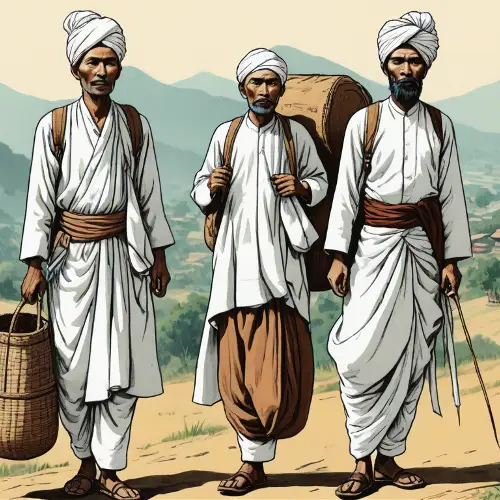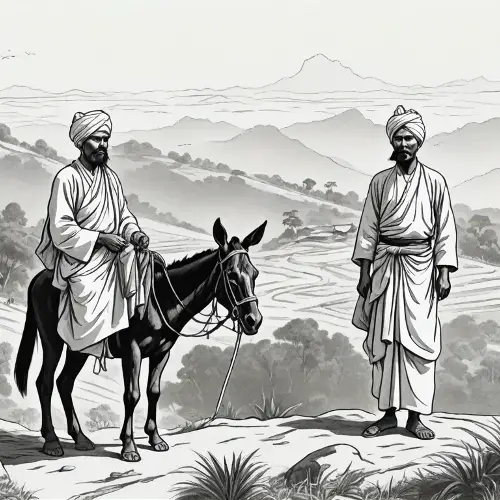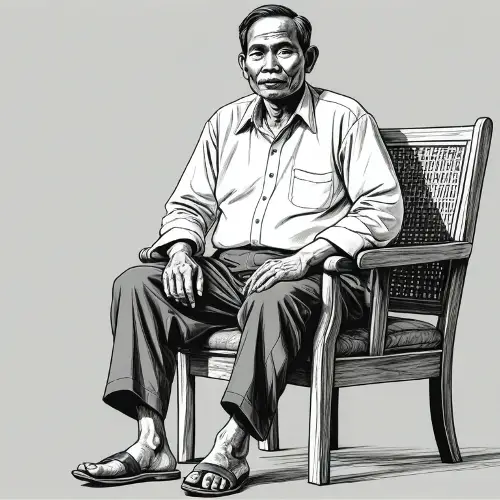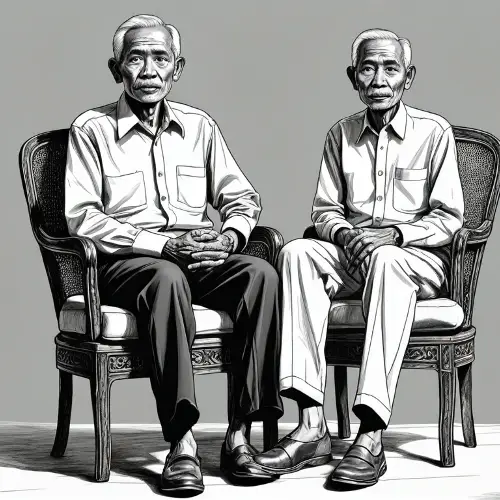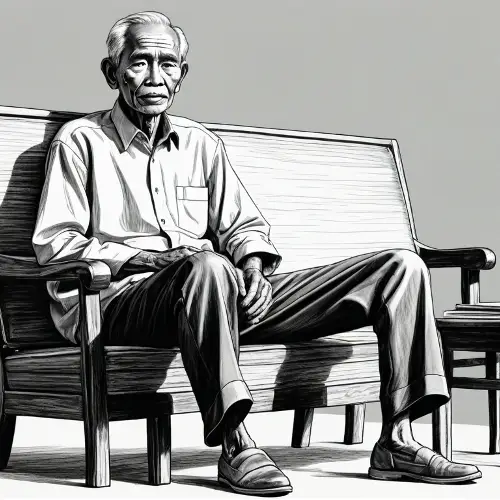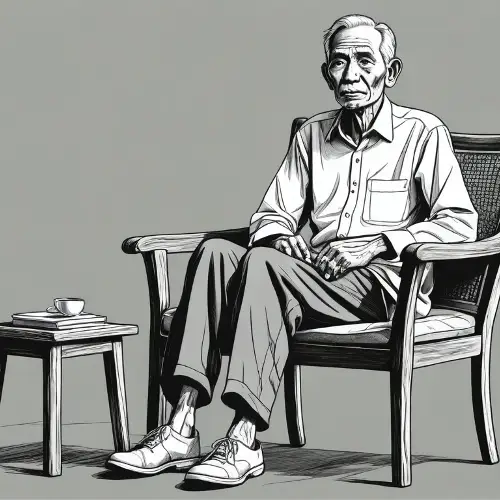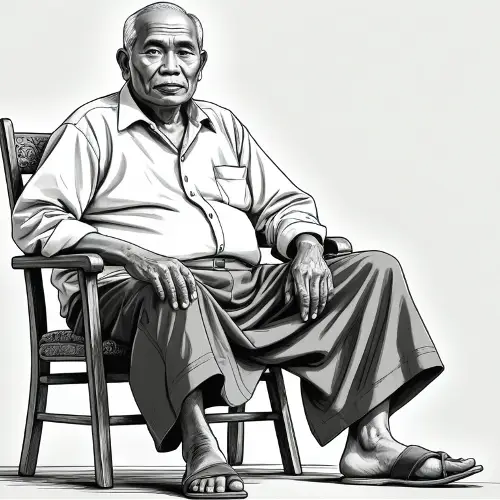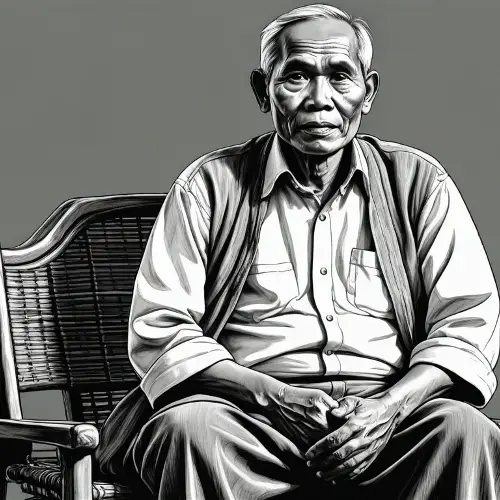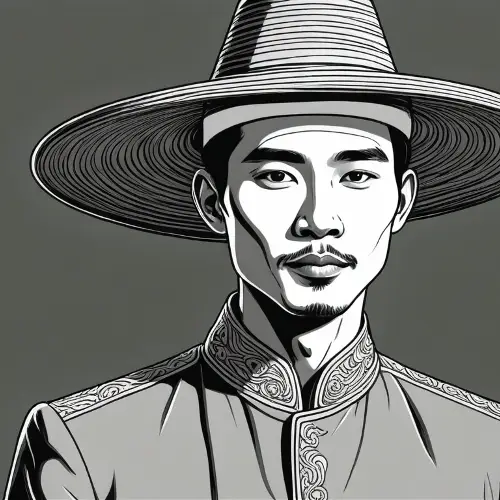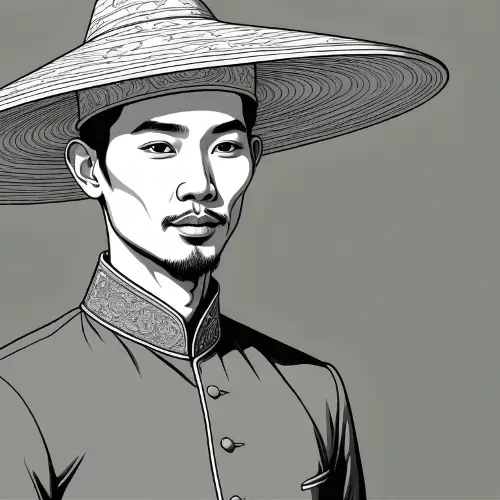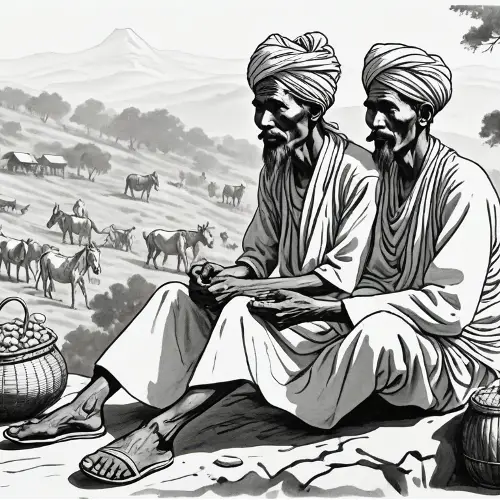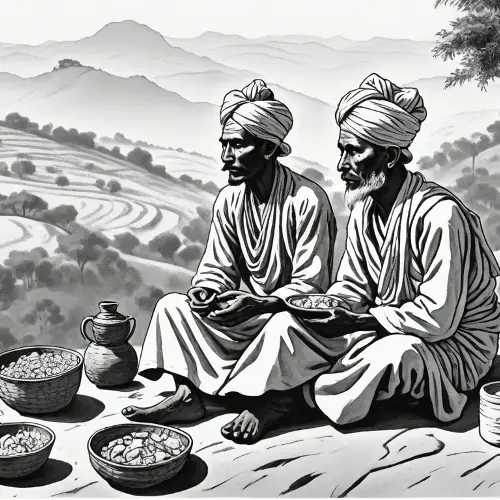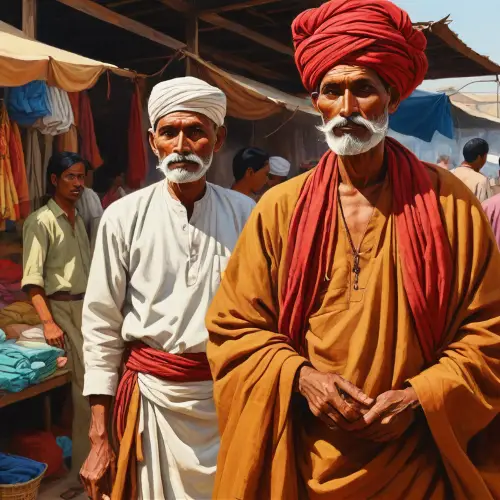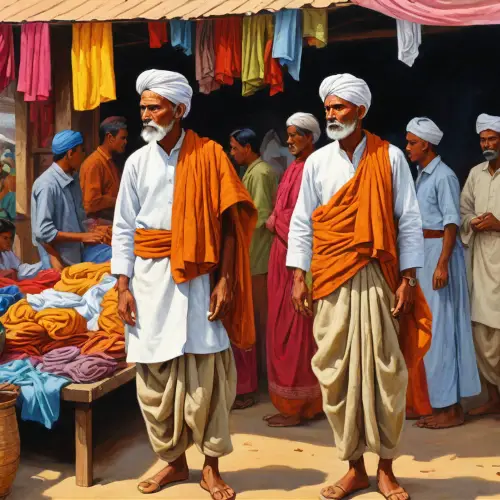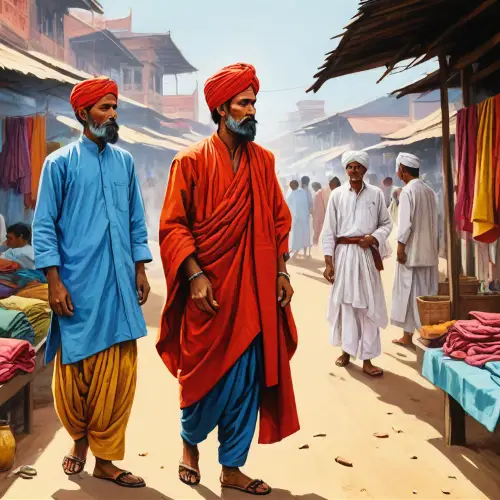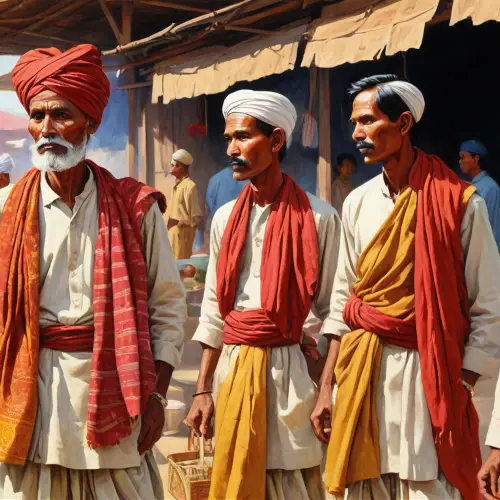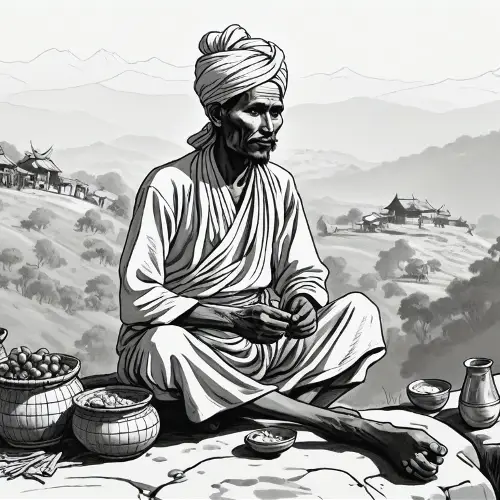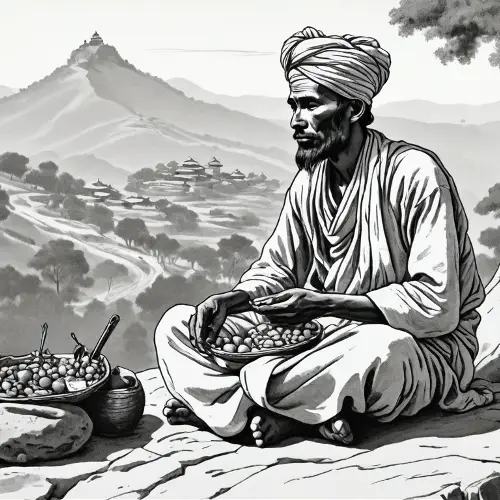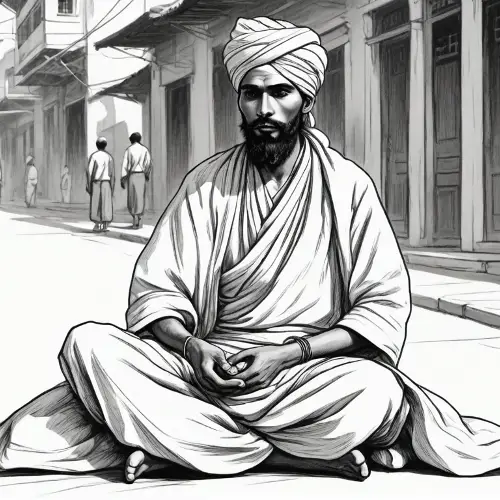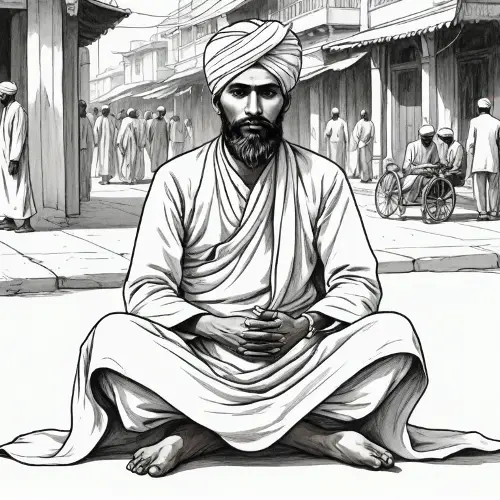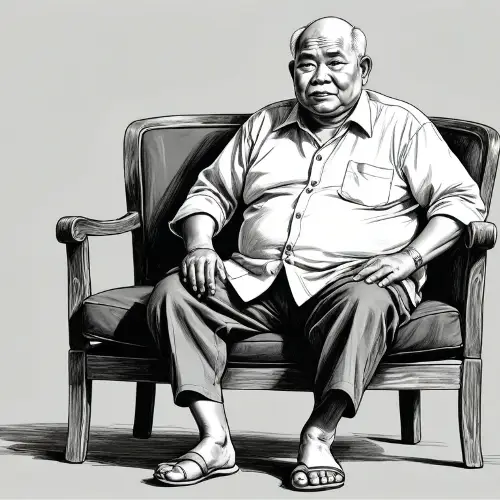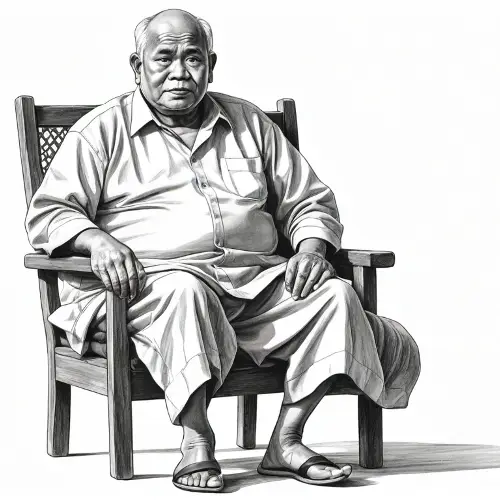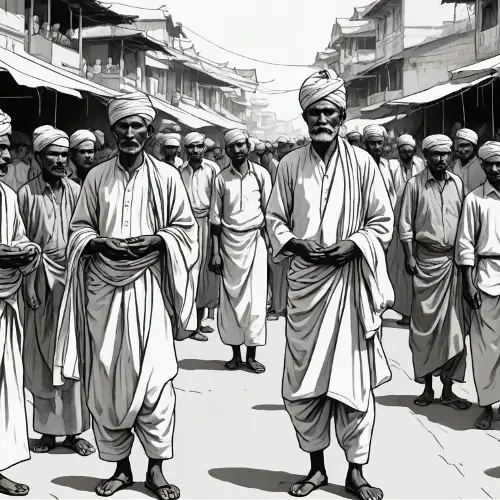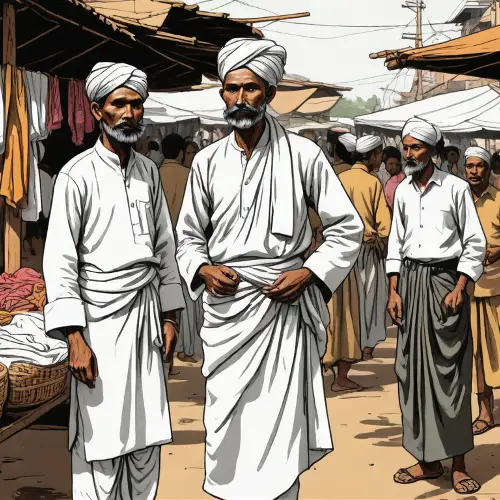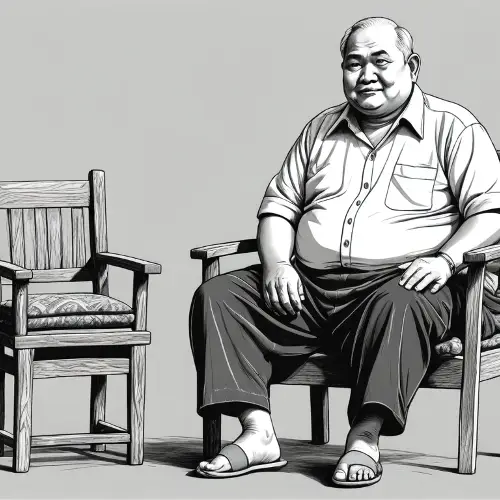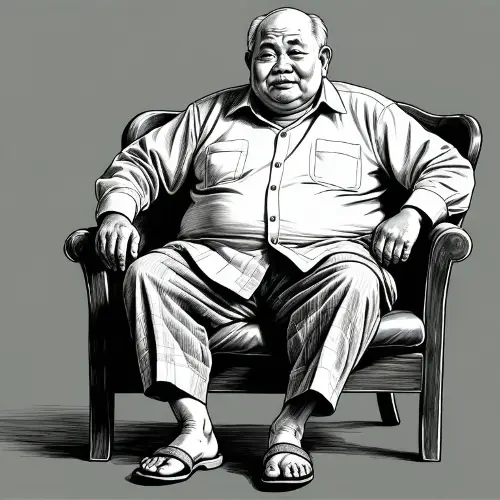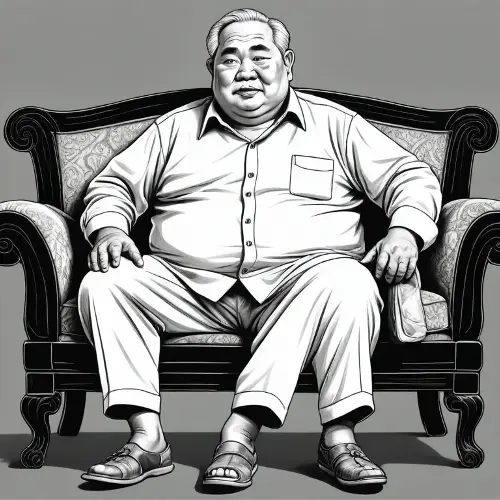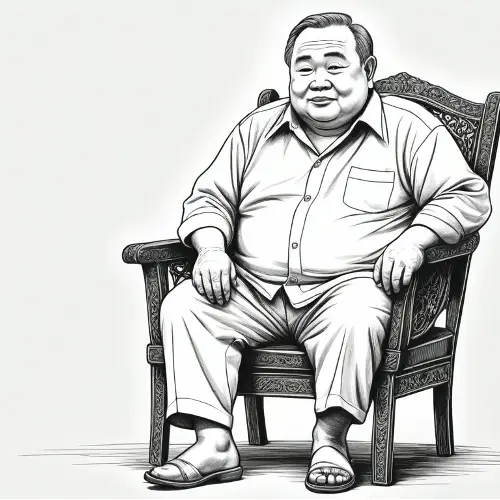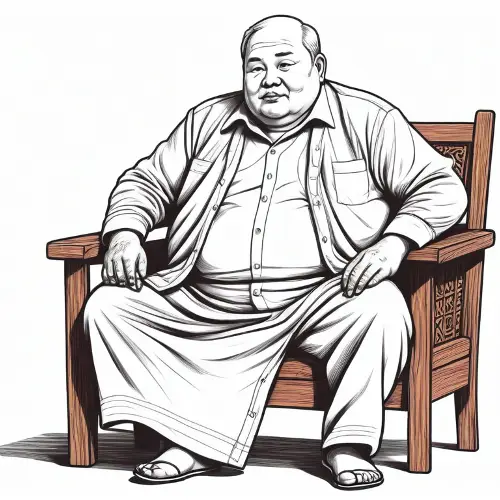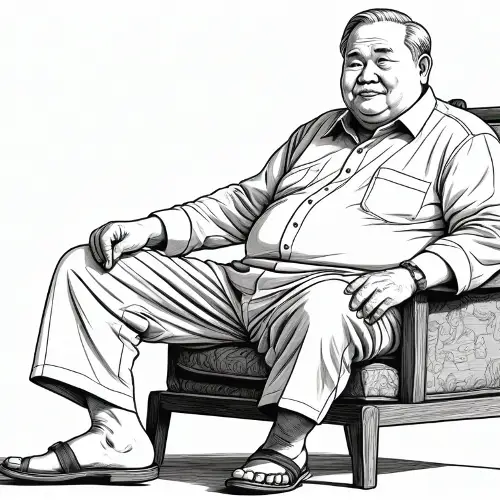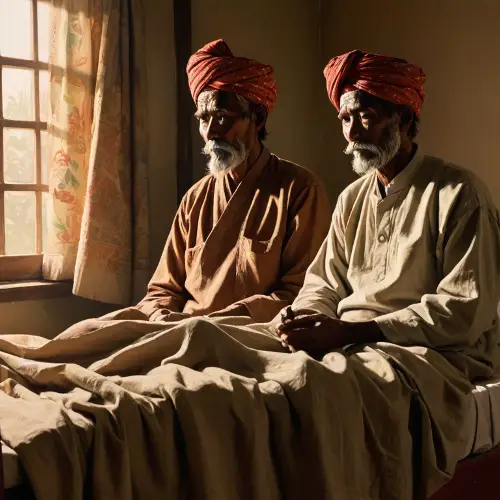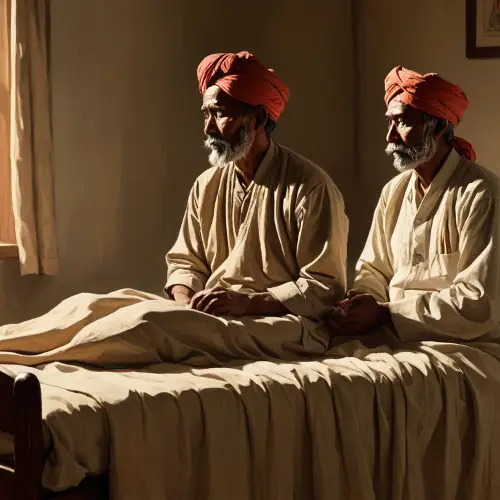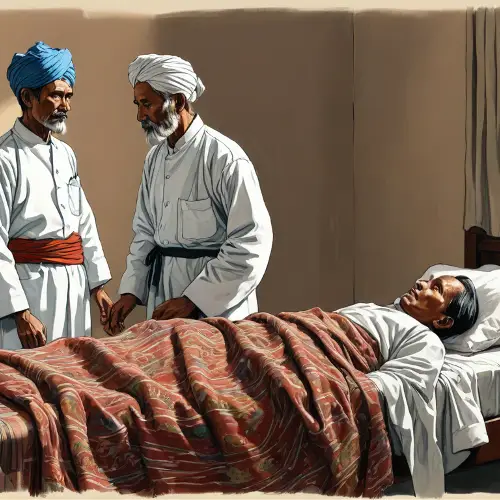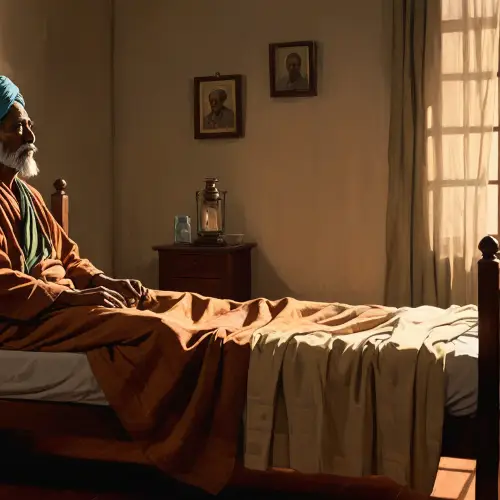Generate an image of a bustling 1940s theater scene in Burma, where the President of Burma stands among a diverse crowd, eagerly watching a captivating performance. The spotlight is on a 13-year-old boy dressed as King Ashoka, delivering a spellbinding theatrical performance, surrounded by intricate props and set pieces that transport the audience to ancient times. Capture the atmosphere of anticipation, cultural richness, and historical resonance in this visually compelling moment. greyscale.
The Marwadi School Stage in Burma in 1935 serves as the backdrop for a nostalgic sketch. Picture a modest stage within the school, embodying the architectural and cultural elements of the Marwadi community. Capture the simplicity of the setting with wooden structures and basic decor. On the stage, imagine students dressed in traditional Marwadi attire, engaged in a cultural or educational event. Symbolic elements, such as books, chalkboards, and cultural artifacts, can be incorporated. The sketch should evoke the essence of education, community, and cultural exchange within the Marwadi school in Burma during the mid-20th century.
1940s comic style, chinese woman, masked suprhero, singing, red costume, high heels
In a dimly lit Burmese hospital room in 1885, a Marwadi man lies on a wooden bed with closed eyes, wearing a vibrant turban and covered by an intricately patterned blanket. The atmosphere is serene, with a mix of curious onlookers, patients, and concerned family members surrounding him. A dedicated doctor, dressed in period-appropriate attire, examines a medical chart nearby. The scene captures a multicultural tapestry of Burma in the late 19th century, with soft lighting creating a poignant moment of cultural convergence and compassion.
Imagine a scene in the hill area of Burma in the year 1880. A distinguished man is depicted, wearing a traditional turban, kurta, and dhoti, standing with a sense of grace. His attire is detailed, reflecting the cultural nuances of the region during that period. Beside him, a mule is tethered, carrying goods or belongings, adding an element of daily life in the hills. The landscape around is hilly, with lush vegetation and perhaps a glimpse of distant mountains. The man may be holding a piece of luggage or engaged in an activity, further emphasizing the context of life in Burma during the late 19th century.
Imagine a scene in the hill area of Burma in the year 1880. A distinguished man is depicted, wearing a traditional turban, kurta, and dhoti, standing with a sense of grace. His attire is detailed, reflecting the cultural nuances of the region during that period. Beside him, a mule is tethered, carrying goods or belongings, adding an element of daily life in the hills. The landscape around is hilly, with lush vegetation and perhaps a glimpse of distant mountains. The man may be holding a piece of luggage or engaged in an activity, further emphasizing the context of life in Burma during the late 19th century.
Imagine a scene in the hill area of Burma in the year 1880. A distinguished man is depicted, wearing a traditional turban, kurta, and dhoti, standing with a sense of grace. His attire is detailed, reflecting the cultural nuances of the region during that period. Beside him, a mule is tethered, carrying goods or belongings, adding an element of daily life in the hills. The landscape around is hilly, with lush vegetation and perhaps a glimpse of distant mountains. The man may be holding a piece of luggage or engaged in an activity, further emphasizing the context of life in Burma during the late 19th century.
Imagine a scene in the hill area of Burma in the year 1880. A distinguished man is depicted, wearing a traditional turban, kurta, and dhoti, standing with a sense of grace. His attire is detailed, reflecting the cultural nuances of the region during that period. Beside him, a mule is tethered. The landscape around is hilly, with lush vegetation and perhaps a glimpse of distant mountains. The man may be holding a piece of luggage or engaged in an activity, further emphasizing the context of life in Burma during the late 19th century.
Envision a scene in the hilly terrain of Burma in the year 1880. A man, adorned in a turban and traditional doti, is seated on a rock or a makeshift surface, savoring a meal. His attire is intricately detailed, reflecting the cultural identity of the region during that period. Beside him, a mule is securely tied, and luggage is neatly arranged nearby, suggesting a pause in a journey or a moment of rest during travel. The hilly backdrop features rugged landscapes, with vegetation and perhaps a glimpse of a winding trail or distant hills. The scene captures a serene moment in the daily life of Burmas hill areas in the late 19th century
45 years old man in burma. wearing lungi and sitting on traditional burmese chair. he is a little fat.charcoal style
60 year old man in burma sitting on a traditional burmese chair. charcoal style
60 year old man in burma sitting on a traditional burmese chair. charcoal style
55 years old man in burma. wearing lungi and sitting on traditional burmese chair. he is a little fat.charcoal style
On a modern stage, at the center of the stage is a handsome young man dressed in simple silver Chinese armor, with thick eyebrows, black eyes, black long hair combed into a high ponytail, and injuries on his body. The stage is disrupted by this young man, and panoramic shots are taken
A Chinese Peking Opera actor performing, geometric shapes, full body, Keith Haring, mixed patterns
Imagine an Indian man in the hilly region of Burma in 1880. Hes sitting on a rock or a simple surface, wearing a MARWADI THIN turban and a traditional doti. The man is depicted enjoying a meal in a serene setting. Beside him, a mule is securely tied, and luggage is neatly arranged, indicating a moment of rest during a journey. The hilly landscape features rugged terrains with greenery and perhaps a glimpse of a winding trail or distant hills. This scene captures a peaceful moment in the daily life of an individual in the hill areas of Burma during the late 19th century.
25 year old burmese born indian man wearing burmese lungi and he is a little fat seen from backside full body. he is entering a pagoda cell. charcoal style, black and white
Create a sketch capturing the cultural fusion in a bustling market scene in Burma circa 1880. Focus on a Marwadi man, dressed in a traditional dhoti and kurta, actively engaged in selling cloth materials. The man could be showcasing vibrant textiles characteristic of Marwadi culture. Detail the merchants attire, paying attention to the intricacies of the dhoti and kurta, as well as any accessories that might signify his cultural background. Emphasize the array of fabrics and textiles displayed in his stall, depicting the rich colors and textures indicative of the cloth trade during that era. Surround the Marwadi cloth merchant with the diverse sights of the market – other stalls, customers exploring, and perhaps fellow merchants. Incorporate architectural elements of the market, suggesting the traditional structures and ambiance of a Burmese market in the late 19th century. Consider the play of light and shadow on the fabrics, creating depth and visual interest in the scene. Capture the expressions on the faces of the merchant and potential customers, conveying the lively interaction in this cultural exchange. In essence, aim to portray the dynamic cultural commerce as the Marwadi man brings the vibrancy of his textiles to the bustling marketplace of 1880 Burma.
Create a sketch capturing the cultural fusion in a bustling market scene in Burma circa 1880. Focus on a Marwadi man, dressed in a traditional dhoti and kurta, actively engaged in selling cloth materials. The man could be showcasing vibrant textiles characteristic of Marwadi culture. Detail the merchants attire, paying attention to the intricacies of the dhoti and kurta, as well as any accessories that might signify his cultural background. Emphasize the array of fabrics and textiles displayed in his stall, depicting the rich colors and textures indicative of the cloth trade during that era. Surround the Marwadi cloth merchant with the diverse sights of the market – other stalls, customers exploring, and perhaps fellow merchants. Incorporate architectural elements of the market, suggesting the traditional structures and ambiance of a Burmese market in the late 19th century. Consider the play of light and shadow on the fabrics, creating depth and visual interest in the scene. Capture the expressions on the faces of the merchant and potential customers, conveying the lively interaction in this cultural exchange. In essence, aim to portray the dynamic cultural commerce as the Marwadi man brings the vibrancy of his textiles to the bustling marketplace of 1880 Burma.
Imagine an Indian man in the hilly region of Burma in 1880. Hes sitting on a rock or a simple surface, wearing a turban and a traditional doti. The man is depicted enjoying a meal in a serene setting. Beside him, a mule is securely tied, and luggage is neatly arranged, indicating a moment of rest during a journey. The hilly landscape features rugged terrains with greenery and perhaps a glimpse of a winding trail or distant hills. This scene captures a peaceful moment in the daily life of an individual in the hill areas of Burma during the late 19th century.
LINE ART SKETCH OF MAN WEARING TURBAN DHOTI KURTA SEATING ON HALF SEATED POSITION ON STREET OF BURMA IN 1880
60 year old little fat man in burma wearing lungi and sitting on a traditional burmese chair. charcoal style.
Create a sketch capturing the cultural fusion in a bustling market scene in Burma circa 1880. Focus on a Marwadi man, dressed in a traditional dhoti and kurta, actively engaged in selling cloth materials. The man could be showcasing vibrant textiles characteristic of Marwadi culture.
60 year old little chubby man in burma wearing lungi and sitting on a traditional burmese chair. charcoal style.
An ultra-realistic 8K scene captures an Indian girl in her late teens, standing on a vibrant stage adorned with colorful backdrops and dance props. She wears an intricately designed traditional costume, vibrant with hues that complement the lively atmosphere of the competition. Amidst the energetic ambiance of the dance competition, the girl turns towards the camera, her eyes alight with a modest yet confident smile. Her expression radiates a blend of joy and anticipation, portraying her enthusiasm for the performance ahead. Realistic details capture the natural movement of her hair and the subtle nuances of her smiling expression. The stage pulsates with dynamic lighting and echoes with the beats of Indian music, creating a vibrant and festive atmosphere. Surrounding her are other performers, the audience's enthusiastic applause, and the infectious energy of the competition. Despite the liveliness of the stage, the focus remains on the girl's poised demeanor and genuine smile. Every detail, from the intricate designs of her costume to the excitement in her eyes, is vividly depicted to immerse viewers in the hyper-realistic experience of a dance competition. This prompt aims to encapsulate the girl's modest yet confident expression amidst the vibrant setting of a dance competition, inviting viewers to feel the excitement and realism of the stage, while appreciating the authenticity of her smile and enthusiasm.
60 year old little chubby man in burma sitting on a traditional burmese chair. black and white. charcoal style
In a traditional Chinese ancient building, a Peking Opera performance was being performed on the stage.
Countless ribbons and colorful stars fluttered down the stage, and in the center of the stage stood a handsome young man wearing simple silver Chinese armor, thick eyebrows, black eyes, black long hair combed into a high ponytail, with injuries on his body. The young mans face was full of surprise
Various idols of gods and goddesses on screen, and an india man age 30 a little overweight reflecting on not seeking material gains through prayer in the context of year 1950 in Myanmar
17 year boy working in a old style cloth shop in burma in the year 1920, sepia tone
17 year boy working in a old style cloth shop in burma in the year 1920, sepia tone
60 year old little chubby man wearing lungi in burma sitting on a traditional burmese chair
15 year old marwadi boy performing on a stage as a king ashoka. sepia tone
In the dimly lit room of a Burmese hospital in the year 1885, a Marwadi man lies peacefully on a wooden bed, his eyes closed as if lost in the realms of slumber. The atmosphere is hushed, with only the faint sounds of distant conversations and the occasional creaking of the wooden floor. The Marwadi man is adorned in traditional attire, wearing a vibrant turban that signifies his cultural identity. The turban is neatly wrapped, its colors muted but still retaining a touch of elegance. The mans face reflects a sense of calmness, perhaps in the midst of recovery or contemplation. A thick blanket covers the Marwadi man, providing warmth in the coolness of the hospital room. The blanket is woven with intricate patterns, showcasing the craftsmanship of the region. Its edges drape gracefully over the sides of the bed. Surrounding the bed are diverse characters, each telling a story of their own. There are curious onlookers, fellow patients, and concerned family members, all with expressions that convey a mix of empathy, hope, and curiosity. The attire of the people varies, representing the multicultural tapestry of Burma in the late 19th century. A wise-looking doctor, dressed in period-appropriate medical attire, stands nearby, examining a medical chart. The doctors face reveals a mix of determination and compassion, suggesting a dedication to the well-being of the patients under their care. The lighting in the room is soft, emanating from a combination of flickering oil lamps and daylight filtering through worn curtains. Shadows dance on the walls, adding depth to the scene. This sketch captures a moment frozen in time, where cultures converge in the heart of a Burmese hospital, and the spirit of compassion transcends the boundaries of time and place.
In the dimly lit room of a Burmese hospital in the year 1885, a Marwadi man lies peacefully on a wooden bed, his eyes closed as if lost in the realms of slumber. The atmosphere is hushed, with only the faint sounds of distant conversations and the occasional creaking of the wooden floor. The Marwadi man is adorned in traditional attire, wearing a vibrant turban that signifies his cultural identity. The turban is neatly wrapped, its colors muted but still retaining a touch of elegance. The mans face reflects a sense of calmness, perhaps in the midst of recovery or contemplation. A thick blanket covers the Marwadi man, providing warmth in the coolness of the hospital room. The blanket is woven with intricate patterns, showcasing the craftsmanship of the region. Its edges drape gracefully over the sides of the bed. Surrounding the bed are diverse characters, each telling a story of their own. There are curious onlookers, fellow patients, and concerned family members, all with expressions that convey a mix of empathy, hope, and curiosity. The attire of the people varies, representing the multicultural tapestry of Burma in the late 19th century. A wise-looking doctor, dressed in period-appropriate medical attire, stands nearby, examining a medical chart. The doctors face reveals a mix of determination and compassion, suggesting a dedication to the well-being of the patients under their care. The lighting in the room is soft, emanating from a combination of flickering oil lamps and daylight filtering through worn curtains. Shadows dance on the walls, adding depth to the scene. This sketch captures a moment frozen in time, where cultures converge in the heart of a Burmese hospital, and the spirit of compassion transcends the boundaries of time and place.























